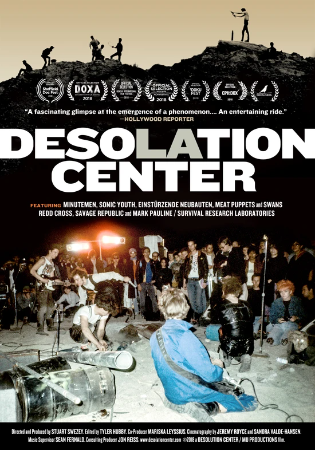
Desolation Center 2018
Distributed by Passion River Films, 154 Mt. Bethel Rd., Warren, NJ 07059; 732-321-0711
Produced by Stuart Swezey
Directed by Stuart Swezey
Streaming, 93 mins
College - General Adult
Alternative Rock Music; Documentaries; Festivals
Date Entered: 07/14/2020
Reviewed by Sam Lohmann, Reference Coordinator and Information Services Librarian, Washington State University VancouverThis documentary provides a nostalgic but still fascinating look into the Los Angeles punk music scene in the mid-1980s, focusing on director Stuart Swezey and the series of five outdoor concerts he helped to organize under the name “Desolation Center.” The film proposes a trajectory from the beginnings of Desolation Center as an all-ages L.A. warehouse venue targeted by frequent police harassment, through the increasingly ambitious, happening-like concerts (four in desert areas of southern California and one on a cruise boat), to the huge commercial music and art festivals of the 1990s and beyond. Interestingly, both Lollapalooza founder Perry Farrell (in his pre-Jane’s Addiction band Psi Com) and members of Survival Research Laboratories (associated with early Burning Man festivals) collaborated with Swezey. However, this narrative is little more than a frame for the main subject, the five concerts, which are portrayed through a mix of concert footage (of varying quality), landscape footage (often stunning), still photos, and talking-head interviews with concertgoers and performers. The comments of the participants, now in middle age, provide a variety of interesting anecdotes that are skillfully interwoven with images and sound from the original events.
The film opens with a compelling portrait of the early 80s L.A. punk scene, highlighting its ethnic, social and stylistic diversity and its antagonism of an especially violent and repressive police department. Chuck Dukowski of Black Flag recounts pranks the group pulled using fake police radio announcements. The scene’s joyfully amateurish, oppositional, mischievous and eclectic tendencies suffuse the event series, including occasional moments of chaos due to the breakdown of equipment or transportation. The events featured important rock bands of the time—Minutemen, Sonic Youth, Meat Puppets, and Red Kross—but also the industrial noise performances of West Berlin’s Einstürzende Neubaten and the experiments of Mark Pauline of Survival Research Laboratories which involved robots and explosives.
The social and economic aspects of the scene could be explored more fully, especially in light of the largely white and male lineups for the Desolation Center festivals. Class is an important and unexamined element here. (Swezey was working in sales for a municipal bond broker while the members of the Minutemen made $1.75 an hour at Jack in the Box.) Despite comments on diversity and the resistance to police brutality, the film does not fully connect the punk scene with social justice struggles. More disappointingly, it glosses over the scene’s occasional overlap with violent far-right movements. Noise musician and art provocateur Boyd Rice, who performed in the second Desolation Center event, is featured and interviewed, with no mention of his promotion of fascist and violently misogynist ideology in the 80s and after.
For me, the highlight of this film is the appearances of the short-lived but influential post-punk trio Minutemen, told through archival footage of the late D. Boon and interviews with surviving members Mike Watt and George Hurley and with Boon’s then-fiancée Linda Kite. At one Desolation Center event in 1984, the Minutemen performed on a boat in the harbor of their working-class port town, San Pedro. Boon’s death in a car crash the following year was clearly devastating for the scene and cast a shadow over Swezey’s fifth and final concert event.
Desolation Center is a flawed but lively and engaging portrait of a distant, still-influential moment in L.A. counterculture. I recommend it for collections in popular music, performing arts, 20th-century U.S. social movements, and California regional studies.